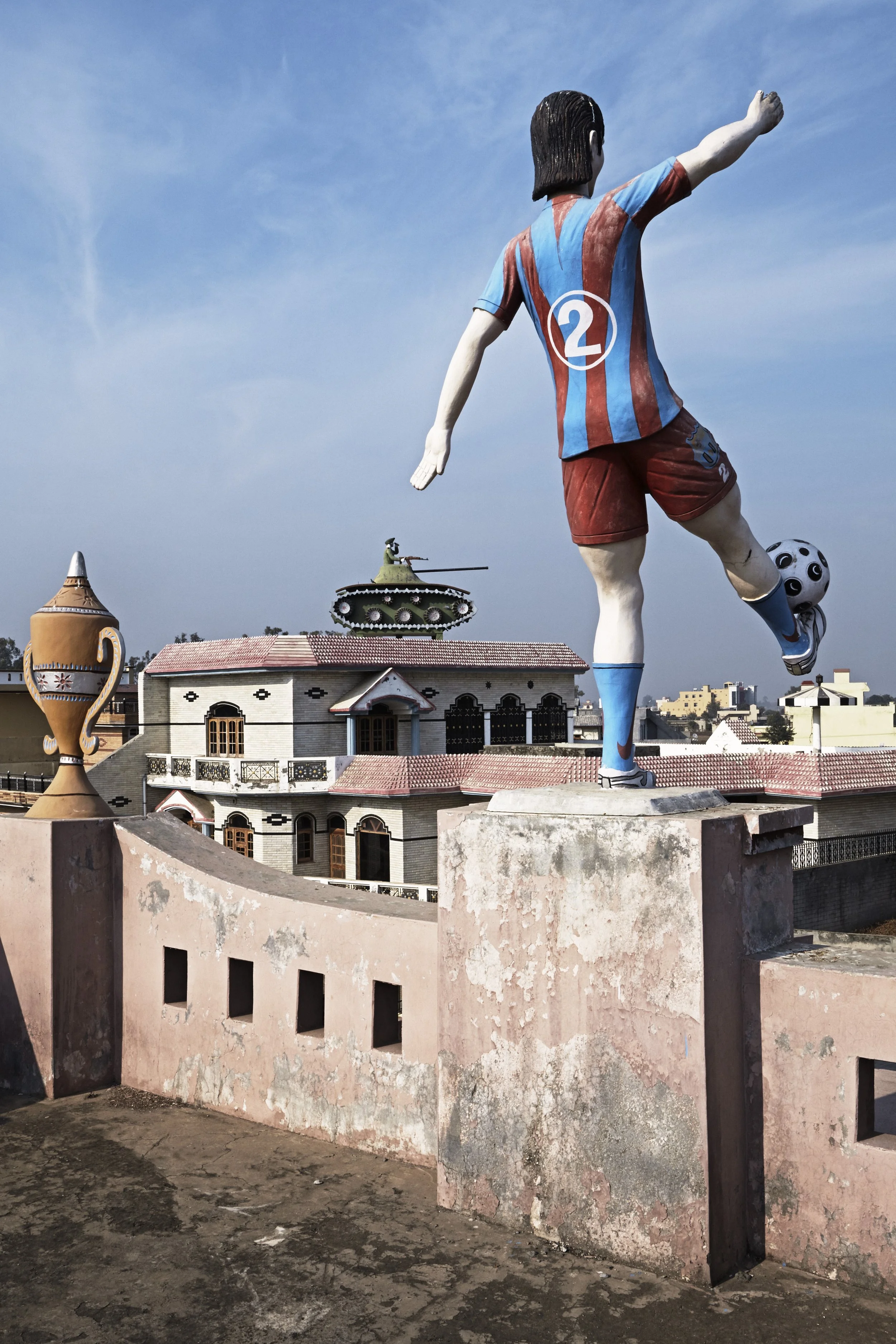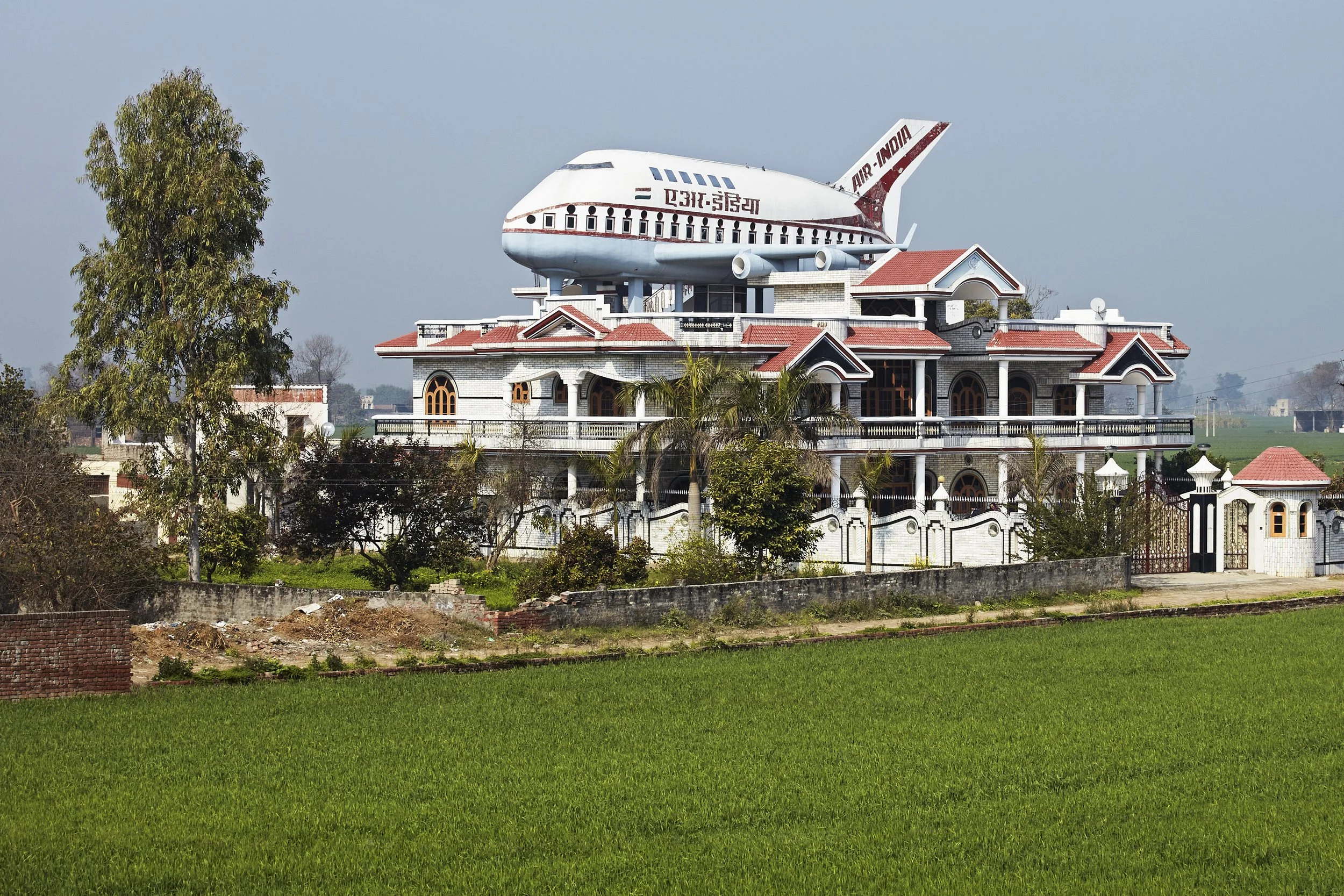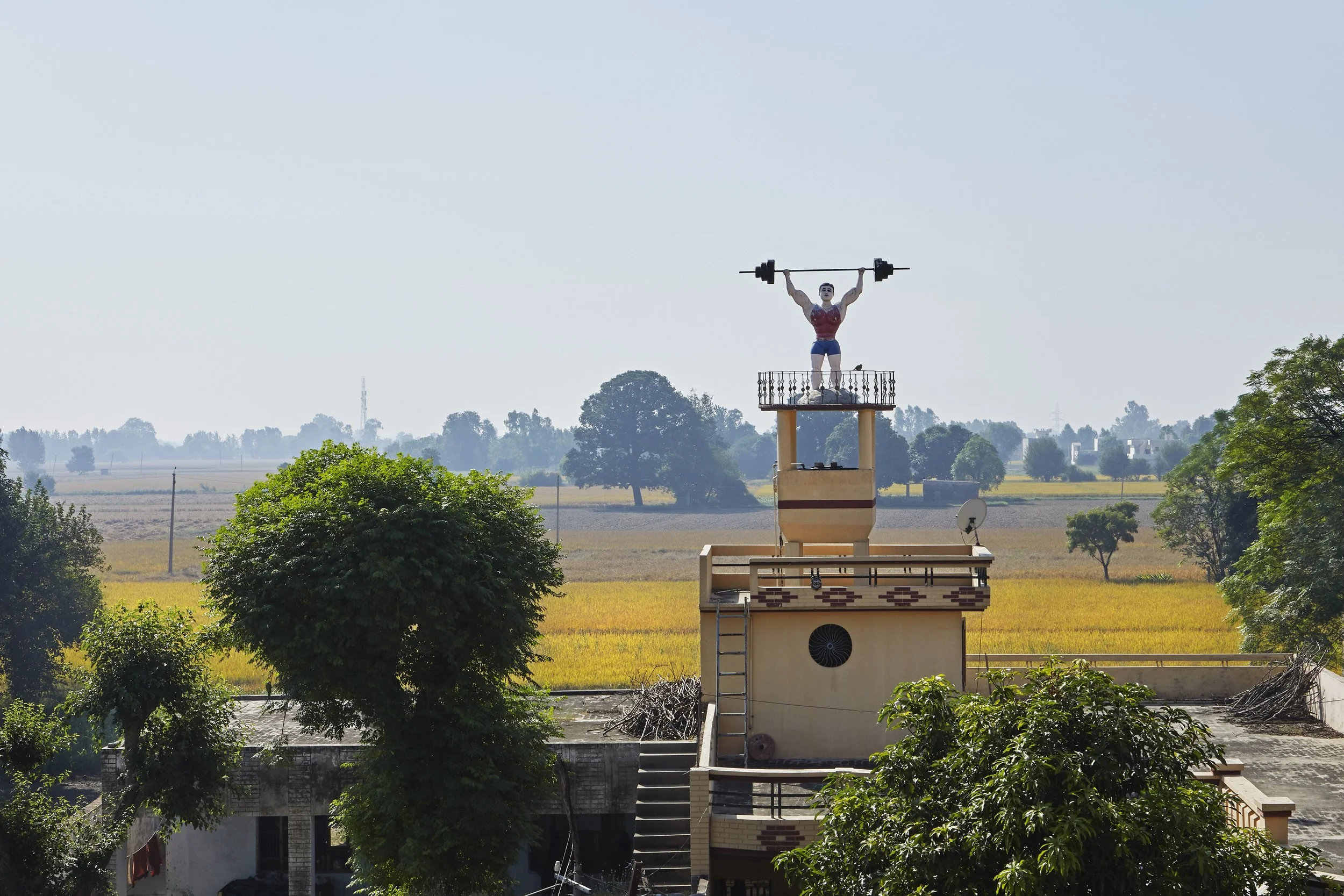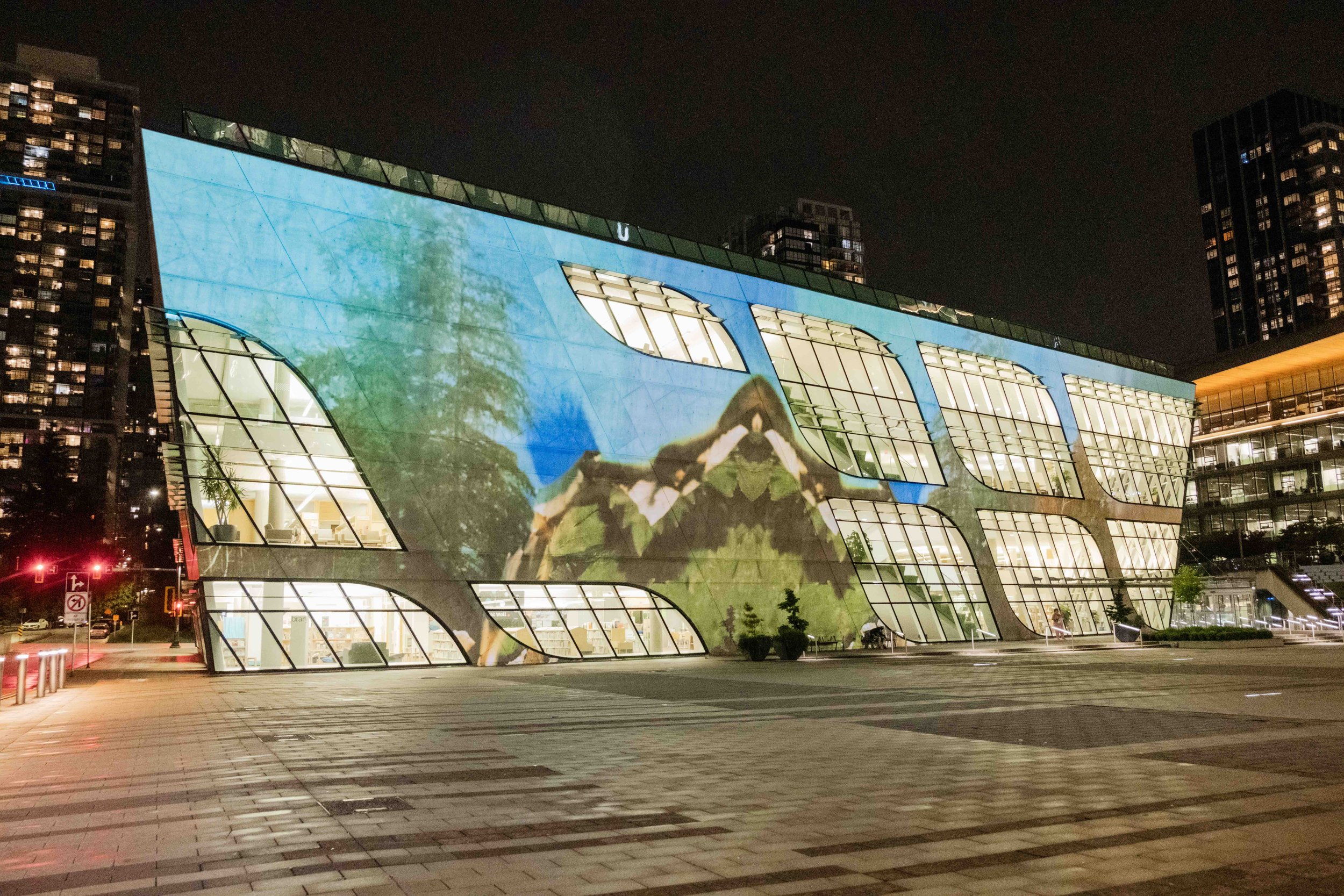Each Punjab rooftop sculpture tells a story in Rajesh Vora's Everyday Monuments
Mumbai photographer works with curator Keith Wallace on Surrey Art Gallery exhibit that speaks to migration, identity, and architecture
Images from Rajesh Vora: Everyday Monuments, 2014–19. Photos courtesy of artist and PHOTOINK, New Delhi.
Surrey Art Gallery presents Rajesh Vora: Everyday Monuments until May 29, as part of the Capture Photography Festival. An online tour with Keith Wallace in conversation with Satwinder Bains, director of the South Asian Studies Institute at the University of the Fraser Valley, takes place on the Gallery’s YouTube channel on April 30.
THE RESULT OF years of work and thousands of kilometres of travelling dusty roads, the new exhibit Rajesh Vora: Everyday Monuments brings together a unique partnership between a Mumbai photographer, a Vancouver contemporary-art curator, and an art gallery in the heart of the West Coast’s Punjabi community.
Now open at the Surrey Art Gallery, the show features 100 of Vora’s photographs of rooftop sculptures that are utterly distinct to the Punjab region of India.
Taking the form of airplanes, falcons, birds, footballs, tanks, and more, the decorative pieces are crafted from wire mesh, rebar and concrete—many serving as functional water tanks. Each is a mark of pride, telling the story of the family and its heritage.
The show came about when Vora and veteran Vancouver curator Keith Wallace’s fascination with the sculptures intersected.
Vora first became obsessed with the roof-top artworks in 2014. Speaking over the phone with Wallace in an interview with Stir, he relates that the journey actually began in 2014, on a visit to a place of worship nicknamed the Airplane Gurdwara, in the Punjab city of Jalandhar; there, devotees offer plastic toy planes to boost their hopes for a visa to leave India. While there, Vora heard of ex-pats who had returned to their villages in Punjab and put sculptures of airplanes on the rooftops of their newly built homes—a proud declaration of their successful emigration.
He started tracking down rooftop sculptures of all sizes and shapes: a pressure cooker to celebrate a family member’s restaurant opening abroad; a soccer ball to pay tribute to a kid who excels at the sport; a tank to commemorate a son who’d served in the army; a tractor to signify a grandfather’s first piece of farm machinery in the village; and even an Eiffel tower to mark a family’s successful emigration to France. Behind each object was a compelling diasporic story.
“I decided to make the trip back in winter, because the light is very, very good then,” relates Vora, a widely published photographer who has focused primarily on architecture. “I thought if I kept the weather conditions and light conditions the same throughout, it might be good for the project.
“In India at this time there was no GPS or maps or anything, so I would just go village to village to look for them, asking for them,” he adds. “Finally I made about five visits in the span of two years, travelling to more than 150 villages over 5,000 kilometres.”
A Punjab village dotted with rooftop sculptures, by Rajesh Vora, in his series “Everyday Monuments”, 2014–19. Photos courtesy of artist and PHOTOINK, New Delhi.
Vora’s carefully framed images celebrate the pastiche of styles in the eclectic architecture of the Punjabi buildings as much as the ornamentation on top. Many of the newer multigenerational houses sit empty for much of the year, serving as summer homes or wedding sites for families who have moved abroad.
“The local architecture that’s happened for the last 30 years is amazing, because the Punjabis who live in Canada or Surrey or New Zealand or the U.K., wherever they go, they come back to Punjab and they have a certain vision of how to build their homes from what they’ve seen in the western world,” he explains. “They mix that in a kind of a style that is not in any architecture books….So the craftsmen, they sort of cleverly merge and absorb all those things also.”
To shoot the images amid tightly packed buildings and narrow alleyways, Vora often has to gain access to the building veranda across from the sculpture.
His most recent trip, in 2019, was with Wallace himself, to research and prepare the final photographs—and add another thousand kilometres or so to the overall journey—for the show at Surrey Art Gallery. It marks the first time that the images will be shown outside of India.
Wallace’s own fascination for the objects had been sparked on his own fine-art-oriented trip to India back in 2006. (Wallace, former director of the Contemporary Art Gallery, has travelled to India many times over three decades, bringing back exhibits by such artists of South Asian descent as Shani Mootoo and Sunil Gupta.) He first discovered the rooftop marvels when he decided to make his first visit to the Punjab, asking a driver to take a detour off the national highway so he could see local villages.
“To be honest I had no idea what they were,” Wallace tells Stir. “They made a big impact, but I just didn't know the story behind them. I had never seen anything like this anywhere else, so it was just lodged in the back of my mind for a long time.”
It was only years later that he would discover Vora’s photographs, after he had a conversation with Delhi-based curator and critic Gayatri Sinha and was able to catch an exhibition of Vora’s works at PHOTOINK in Delhi.
Through further research, Wallace started to understand the unique evolution of the sculptures in Punjab—that they had started as actual working water tanks, but that later versions sat atop boxed-in watertanks that served as “plinths” for the art pieces.
“What was interesting to me was I didn't really know how to categorize them,” Wallace explains. “Is it folk art? Is it sculpture? Is it architecture? It's such an organic thing that evolved only in the villages, not in the larger towns or the cities—so that interested me, too. And also it was a form of public art—not a self-conscious thing that ‘I’m making public art’ but more symbolizing something about the family.”
Both the artist and the curator are excited to show the images to the Punjabi-Canadian community in Surrey itself.
“A large part of the population in Surrey comes from these villages, so they would be familiar with them, but young Punjabis have no idea that these exist,” Wallace says. “So it's going to be a real sharing of culture and a learning experience.”
Adds Vora: “It’s going to be a revelation for a lot of them.”
Vora says the tradition is at no risk of dying out. Roof sculptures continue to be added to the Punjab’s village landscape every year.
“They’re commissioning new ones and it is spreading very fast,” he reports. “You’ll see new forms emerging over the next few years. One thing in Punjab: they don't want to do all the same thing. They want to do something different. That's kind of the Punjabi way of showing themselves; that's how we get so much variety. Even with the soccer ball, it’s all different colours and different forms—it’s not the same soccer ball everywhere.
“That's also the same for all of India: there are no rules like ‘You can only build a house in a particular way,’” he adds. “You can do what you want. So I think everybody has their own Taj Mahal, you could say.”
Rajesh Vora, from the series Everyday Monuments, 2014–19, inkjet print, dimensions variable. Photos courtesy of artist and PHOTOINK, New Delhi.
















